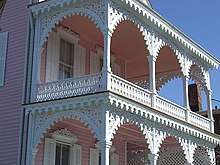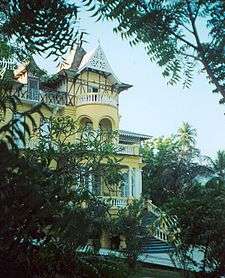Gingerbread (architecture)
Gingerbread is an architectural style that consists of elaborately detailed embellishment known as gingerbread trim.[1] It is more specifically used to describe the work of American designers in the late 1860s and 70's.[2] It was loosely based on the Picturesque period of English architecture in the 1830s and is used in the stick style of architecture.[2]

History
During the 1830s and 1840s, American home builders started interpreting the European Gothic Revival architecture, which had elaborate masonry details, in wood to decorate American timber frame homes. The early designs started with simple stickwork such as vertical sawtooth siding. By the middle of the 19th century, with the invention of the steam-powered scroll saw, the mass production of thin boards that were cut into a variety of ornamental parts had helped builders to transform simple cottages into unique houses.[3][4]
Not everyone agreed with this architectural style. Andrew Jackson Downing, a prominent advocate of the Gothic Revival criticized this style in his Architecture of Country Houses in 1852. He classified homes in the United States into three types: villas for the wealthy, cottages for working people and farmhouses for farmers. He argued that the lower-cost cottages which were small in size and had simplistic style should not be ornamented with elaborated embellishment of a villa. He also pointed out that the vergeboard of the Rural Gothic gable should have been carefully carved in thick and solid plank to appreciate its beauty instead of an ornamental part which was "sawn out of thin board, so as to have a frippery and 'gingerbread' look which (degraded), rather than (elevated), the beauty of the cottage."[5]
The style lived on and became flourished in the residential areas of Chicago in the 1860s. That didn't last very long, the Great Chicago Fire in 1871 destroyed many of those buildings.[6] Some attributed a cause of the fire to be worsen to the cheap construction materials and the gingerbread decorations in hoping other cities would heed the warning.[7] Still, the style continued to spread to the West. By the 1870s, San Francisco had many gingerbread houses at a similar level of Chicago ten years earlier.
In 1878, a fire in Cape May, New Jersey destroyed 30 blocks of properties of this seaside town. The town rebuilt quickly. Many of those were built with lots of gingerbread trim, gables and turrets. This resulted in a high concentration of late 19th century buildings in the town.[8][9] According to the National Register of Historic Places, "Cape May has one of the largest collections of late 19th century frame buildings left in the United States. It contains over 600 summer houses, old hotels, and commercial structures that give it a homogeneous architectural character, a kind of textbook of vernacular American building."[10]
In Haiti

Wooden residential buildings of wealthy individuals in Haiti during the Gingerbread era between 1880 and 1920 had a unique architecture that combined the local traditions and adaptation of foreign influences. The adaptation was influenced by many factors including manuals of styles that were circulated from Europe and North America, Haitian architects who studied abroad, and French artisans who set up woodworking shops to train Haitian artisans.[11] Those Gingerbread houses were highly decorative with fretworks, latticeworks with patterns that are unique to Haitian. The structures of this style typically have large windows and doors, tall ceilings, large attics, and deep porches.[12][13]
Gingerbread was coined by American tourists in the 1950s, who appreciated the style which bore similarity to that of the Victorian-era buildings with gingerbread trim in the United States.[13][14]
History
The movement of the style began in 1881 with the Haitian National Palace. In 1895, three young Haitians—Georges Baussan, Léon Mathon, and Joseph-Eugène Maximilien—traveled to Paris to study architecture, were inspired to build upon the nascent architectural movement, and modified the style to the climate in Haiti by designing homes with vibrant patterns and flamboyant colors to the French resort architecture.[13]
Characteristics
The gingerbread house by design combines architectural knowledge that stemmed abroad, into an understanding of the Caribbean climate and its living conditions. They were constructed with tall doors, high ceilings, with steep turret roofs to redirect hot air above its inhabitable rooms, along with a cross-breeze of louvred shutter windows on all sides instead of glass to offset the most scorching of days, and flexible timber frames with the innate ability to weather some of the toughest storms and tremors, built with wrap-around verandas.[15][16] The houses are usually constructed out of wood, masonry, or stone and clay.[13][17]
Preservation
This specific architectural heritage in Haiti is now seriously threatened as the natural aging of the wood, the weather, the high cost of restoration and repairs are all detrimental to the survival of this style. The style has been nominated to the 2010 World Monuments Watch.[13] Surprisingly, only five percent of the estimated 300,000 houses were partially or fully collapsed due to the 2010 earthquake, in contrast to 40% of all other structures that had been considered to be in better condition, which leaves U.S. conservation experts to believe that this architecture can be a model for seismic-resistant activity of the future.[18][16][15]
Notable examples
 Many Victorian-era buildings in the Cape May Historic District[19]
Many Victorian-era buildings in the Cape May Historic District[19]- Hotel Oloffson, a Gingerbread hotel in Port-au-Prince, Haiti
.jpg) Gingerbread cottages in Oak Bluffs, Massachusetts
Gingerbread cottages in Oak Bluffs, Massachusetts
References
- Gage, Marjorie E. "Gingerbread Trim: Feast your eyes on these ornate Victorian-era embellishments". This Old House Ventures. Retrieved 4 January 2020.
- "Gingerbread | architecture". Encyclopedia Britannica. Retrieved 2020-01-04.
- Gage, Marjorie E. "Gingerbread Trim: Feast your eyes on these ornate Victorian-era embellishments". This Old House Ventures. Retrieved 12 January 2020.
- "Gingerbread History". Lund-Hoel House Museum. Retrieved 12 January 2020.
- Downing, Andrew Jackson (1852). The Architecture of Country Houses: Including Designs for Cottages, Farm Houses, and Villas, with Remarks on Interiors, Furniture, and the Best Modes of Warming and Ventilating. D. Appleton & Company. pp. 41–43. Retrieved 12 January 2020.
- "Correspondence". The American Architect and Building News. James R. Osgood & Co. 1: 110. 1 April 1876. Retrieved 12 January 2020.
- "Fractional Currency". The Chronicle. 9: 8. 1872. Retrieved 12 January 2020.
- "Victorian Cape May". Cape May Times. Retrieved 6 January 2020.
- "Textbook Victorians". Old-House Journal (October 2009): 54. Retrieved 6 January 2020.
- "Cape May Historic District". National Park Service. Retrieved 12 January 2020.
- The Gingerbread Houses of Port-au-Prince, Haiti (PDF). Trustees of Columbia University in the City of New York. 2016. pp. 12–13. Retrieved 6 January 2020.
- "Gingerbread Neighborhood". World Monuments Fund. Retrieved 6 January 2020.
- "Preserving Haiti's Gingerbread Houses" (PDF). World Monument Fund (WMF). Archived from the original (PDF) on 20 March 2013. Retrieved 27 January 2015.
- Phillips, Anghelen Arrington (1975). Gingerbread Houses: Haiti's Endangered Species. Port-au-Prince: Imprimerie Henri Deschamps.
- Katz, Marisa Mazria, ed. (28 April 2011). "The Gingerbread Reclamation". Wall Street Journal. Retrieved 1 July 2015.
- Rose, Steven (ed.). "Haiti: Rocked to its Foundations". 11 January 2011. Retrieved 1 July 2015.
- Jackson, Leslie, ed. (1 July 2010). "What We Can Learn from Haiti". Home Energy. Retrieved 1 July 2015.
- Sokol, David, ed. (1 June 2011). "Haiti's Gingerbread Houses Focus of Preservation Efforts". Architectural Record. Retrieved 1 July 2015.
- "Textbook Victorians". Old-House Journal (October 2009): 54. Retrieved 6 January 2020.
Further reading
External links
| Wikimedia Commons has media related to Gingerbread house (architecture). |